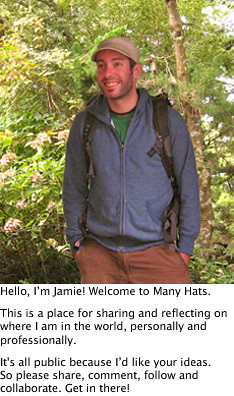I just finished reading “Living and Learning with New Media: Summary of findings from the digital youth project”, focusing in particular on their chapter that explored the media interaction stage of “Messing Around”. They define this as a stage of engagement with media that involves “tinkering, exploring and extending understanding.” and go into some detail to cite a range of examples where youth cultivate skills and interests in working with technology through only lightly purposeful exploration, that can then potentially develop into more focused and directional behaviours.
I fully agree that this sort of messing around is a valuable and possibly inevitable stage in the processes of exploring a new set of tools or potentials, but I definitely would argue that it is in no way unique to the fields of new media or online communications. Furthermore, though this article focuses on teenage youth, I don’t believe that the messing around stage is unique to this age group.
What struck me immediately was how their research connected with a post and comment I’d recently made on my classroom blog, here. In that post I discussed how:
Near the beginning of the year we always take time to really explore the tools of our classroom. Before students can be expected to use math tools and manipulatives for specific tasks, they need time to explore, experiment and play with them freely. This activity can teach me a lot about their approach to mathematical processes, and is a ton of fun for the class!
Clearly, what these seven year olds are doing is “messing around”. They tinker, they play, they use tools for purposes that they’ve seen done before, and they devise new ways to apply them as well. It’s often social and collaborative, or just as often the equivalent of someone sitting alone working something out.
Check out the manipulative play “messing around”:
Messing around is by no means just for new tech, or for math toys… It’s the way we begin to explore the parameters and potentials of any new set of tools, and it happens best when there is little external motivation or goal-setting, lots of time, and lots of opportunities to take risks.
It’s time to catch up on my reading.
I’ve spent so much time finicking around with getting this blog the way I temporarily want it (with the clear understanding that ideally, it would be nothing like this, really, given the time…), that anyways, I’ve already fallen behind on posting about the articles I’ve been reading. The immediate challenge with that, of course, is that by the time I get to posting about them, I basically have to go back and re-read to figure out what all my little highlights and post-its were about (though Diigo clearly exceeds the delicious scope by having these mark-up features… a whole different beast…).
I’ve just re-read
Disrupting Class: Student-Centric Education Is the Future
How radical innovation will change the way we teach and kids learn.
By Clayton M. Christensen, Michael B. Horn
and there are things that are still sticking in my throat.
Naturally, I agree with his premise that student-centred learning is a more resonant philosophical approach than teacher-centred, but he also seems to be waving this flag of glory for students sitting in noise-cancelling headphones learning by a range of multiple intelligences that are all catered to by digital, screen-based means. First of all, I’m sitting here in noise-cancelling headphones now, trying to block out my partner’s Skype conversation with her sister and three-year old niece. The headphones aren’t useless, but I’m struggling to maintain my bubble of auditory serenity. Second of all, the pitch for multiple intelligences being served by a variety of screen-based means rings a bit false for me. I have no doubt that the grouchy construction worker helping the student in the article assemble mandarin sentences is far superior (in terms of range, immediacy and motivational capacity) to some of the textbooky teaching it’s meant to replace, but I think it’s delusional to imagine that it’s going to serve a whole new breed of learners. In a way I think it’s exactly the same learners who are successful with the textbooks who’ll likely be successful with this sort of software.
Generally, I think that the premise of the article rubs up wrong against my primary belief in the value of collaborative learning and hands-on experience. Making friends, finding co-conspirators, getting dirty, taking public risks… These seem to me to have a lot of value that’s hard to replicate or replace in the future classrooms described.
A crux of the article rests on the difference between innovations that sustain the status quo through incremental improvements, and those that disrupt it by reaching out to consumers (students) who wouldn’t be reached otherwise. My problem with it is that while that part of the premise rings true, perhaps the examples he proposes of disruptions, seem at times awfully sustaining.
I’m going to have to re-read it again.
MY CLASS BLOG
This is my classy, yet personal blog. For my less personal –but perhaps classier– classroom blogs, click here, or here.MANY HATS in your inbox
Subscribe to Many Hats...

many hats by Jamie Raskin is licensed under a Creative Commons Attribution-NonCommercial-ShareAlike 3.0 Unported License.Details… details…
CATEGORIES
@jamieraskin
My TweetsINVASION PROGRESS
HISTORY
MANY COMMENTS








